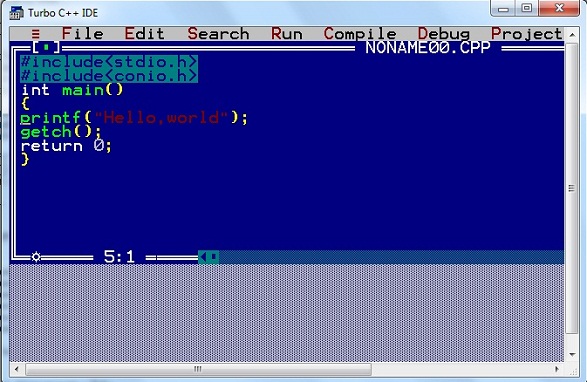

- #How to write c code in terminal how to#
- #How to write c code in terminal install#
- #How to write c code in terminal full#
In the Visual Studio installer, select the C++ build tools workload, and choose Install.īefore you can build a C or C++ program on the command line, you must verify that the tools are installed, and that you can access them from the command line.
#How to write c code in terminal install#
To install only the command-line toolset, download Build Tools for Visual Studio from the Visual Studio downloads page and run the installer. It's perfect for build labs or classroom exercises and installs relatively quickly. The Build Tools for Visual Studio version of Visual Studio installs only the command-line toolset, the compilers, tools, and libraries you need to build C and C++ programs.
#How to write c code in terminal how to#
For information on these features and how to download and install Visual Studio, including the free Visual Studio Community edition, see Install Visual Studio. Visual Studio is a powerful integrated development environment that supports a full-featured editor, resource managers, debuggers, and compilers for many languages and platforms. To complete this walkthrough, you must have installed either Visual Studio and the optional Visual C++ components, or the Build Tools for Visual Studio.

If you'd like to try the Visual Studio IDE instead of using the command line, see Walkthrough: Working with Projects and Solutions (C++) or Using the Visual Studio IDE for C++ Desktop Development. If you'd rather work in C++ on the command line, see Walkthrough: Compiling a Native C++ Program on the Command Line. This walkthrough shows how to create a basic, "Hello, World"-style C program by using a text editor, and then compile it on the command line.
#How to write c code in terminal full#
Public static void main(String args) throws IOException, InterruptedException įor (int i = 0 i < messages.Visual C++ includes a C compiler that you can use to create everything from basic console programs to full Windows Desktop applications, mobile apps, and more. Thanks, I modified the server to listen on multiple ports and to multiple clients. Post navigation ← Square Root Algorithms in Scheme Sockets Programming Example in C: Server Converts Strings to Uppercase → This entry was posted in C, Networking on Apby Daniel Scocco. You might also like: Sockets Programming in C Using UDP Datagrams

*- Read the message from the server into the buffer -*/ *- Connect the socket to the server using the address struct -*/Ĭonnect(clientSocket, (struct sockaddr *) &serverAddr, addr_size) *- Send message to the socket of the incoming connection -*/ NewSocket = accept(welcomeSocket, (struct sockaddr *) &serverStorage, &addr_size) *- Accept call creates a new socket for the incoming connection -*/ *- Listen on the socket, with 5 max connection requests queued -*/ *- Bind the address struct to the socket -*/īind(welcomeSocket, (struct sockaddr *) &serverAddr, sizeof(serverAddr)) Memset(serverAddr.sin_zero, '\0', sizeof serverAddr.sin_zero) * Set all bits of the padding field to 0 */ * Set port number, using htons function to use proper byte order */ *- Configure settings of the server address struct -*/ WelcomeSocket = socket(PF_INET, SOCK_STREAM, 0) * 1) Internet domain 2) Stream socket 3) Default protocol (TCP in this case) */ Third, if you want more details about the functions or their arguments please check the man page of each one.įinally, to test the code you just need to run the server on a terminal and then run the client on a different terminal (or run the server as a background process and then run the client on the same terminal). You should implement those checks if you are going to use the code for a real project. Second, I am not doing error checking on most function calls. If you want your code to be IPV4-IPV6 agnostic, IP agnostic and portable to different plataforms you can use the getaddrinfo() function, as explained in this tutorial. Keep in mind that I am configuring the settings manually. Basically the client connects to the server, the server sends the message “Hello World”, and the client prints the received message. Below you’ll find an example of a very simple client-server program in C.


 0 kommentar(er)
0 kommentar(er)
